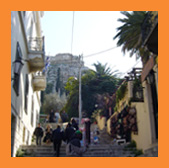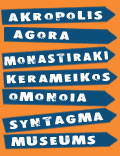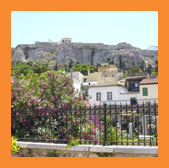




Plaka lies below Anafiotika and fills the space between
the ancient and modern city, stretching to Odos Ermou and Syntagma Square
to the north. This was the centre of population from Byzantine times through
to Greek independence and therefore can be called Athens Old Town. The
maze of narrow streets, mostly traffic-free, is a delight to explore and
there are numerous shops and eateries to choose from. Playful cats dart
down the narrow alleyways, and you may be lucky to hear the Terpsichordean
notes of the laterna drifting through the streets-these hand-turned barrel
organs are now becoming extremely rare. Plaka is particularly atmospheric
in the evenings when locals enjoy a volta,
or stroll, before dinner and tavernas set tables out on the narrow side
streets. It is almost a living museum with Byzantine Churches, Neo-Classical
mansions housing galleries olcol- lectables stores and a wealth of historical
detail at every turn. Do look beyond the tempting shop fronts to really
get the most out of your tour. Thougil you'll want to simply follow your
nose around the district, here are the locations of the main historical
attractions of Plaka.
At Kidathineon 17 Street you'll find the Museum of Greek Folk Art, which offers an interesting collection of embroidery, lace and numerous liturgical garments. Spinning and weaving is also highlighted along with traditional puppets and festival masks and costumes. The collection features artefacts from allover Greece and her islands. Other divisions of the folk art museum can be found around the city.
On the southern end of Odos Adrianou, in a small square
surrounded by cafes, is the Monument of Lysicrates. Dating from the 4th
century BC, it consists of a series of curved panels and columns creating
a circular structure supporting a dome made from a single block of Pentelic
marble. Originally, this would have been topped by a bronze tripod, a
prize awarded in choral competitions during the Classical era. In the
18th century a Capuchin monastery occupied the land all around the monument
and the interior of the base was used as a guest room. Lord Byron stayed
here in 1810 and is said to have written some of his work while enjoying
the seclusion
.
One mansion on Odos Panos, high up near the Akropolis, has been turned
into a museum. The Kanellopoulos Museum, which opened in 1976, has a family
collection of artefacts from many eras of Athens' history. Mycenaean figurines
and pottery, Classical Greek and Roman sculpture, and Byzantine icons,
frescoes and tapestries are all well-displayed and illustrate very effectively
the varied influences that make up the history of the city.
![]()

